
Tell us what you need to find a matching loft conversion specialist

Get free quotes from professionals near you

Compare offers and choose the one that best matches your need
- Householdquotes.co.uk
- Stairlifts
- Standing Stairlifts
Your Complete Guide to Standing Stair Lifts

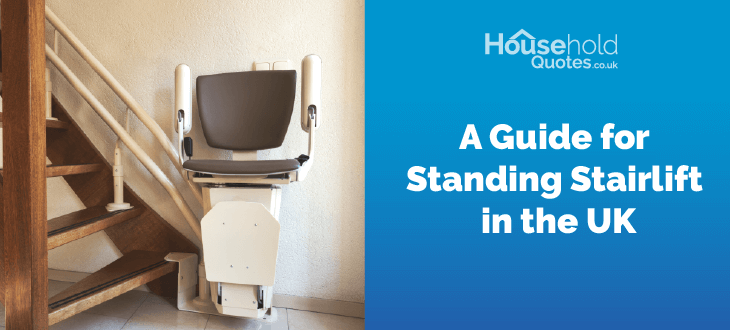
- For a standard standing stair lift designed for a straight staircase, the price range typically falls between £2,000 and £5,000. If you're looking for a standing stair lift that is either customized or designed for a curved staircase, the costs can vary from £5,000 to £10,000 or even higher.
- The cost of a standing stair lift depends on several factors such as type of lift, features and options, brand of the stairlift, customization, installation, warranty and service.
- The most popular stairlift brands in the UK are: Stannah Stairlift, Acorn Stairlift, Handicare Stairlift, Brooks Stairlift and Platinum Stairlift.
For individuals with mobility challenges, navigating stairs can be a daunting task. However, stairlifts offer a practical solution, allowing users to move effortlessly between different levels of their homes.
This comprehensive guide aims to illuminate the world of standing stair lifts, offering invaluable insights into their functionality, benefits, installation process, maintenance requirements, and stairlifts prices in the UK.
Whether you're a prospective user seeking greater independence or a caregiver exploring solutions for a loved one, join us as we delve into everything you need to know about standing stair lifts in the UK. From understanding their unique features to navigating the intricacies of installation and maintenance, this guide is your roadmap to enhanced mobility and comfort within your home.
- Describe your needs
- Get free quotes
- Choose the best offer
It only takes 30 seconds

What is a standing stair lift?
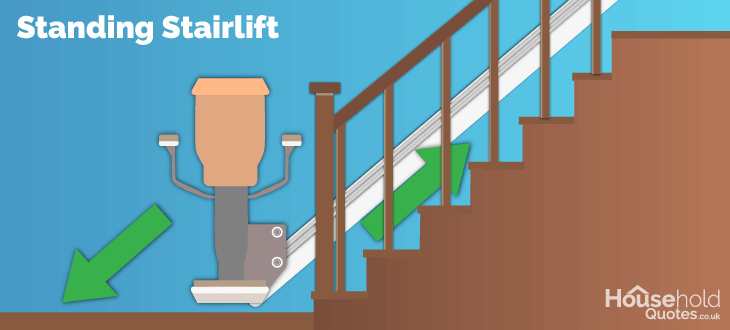
Unlike traditional seated stair lifts, which necessitate users to sit down during transport, standing stair lifts allow individuals to remain in a standing position throughout the journey. Here's a breakdown of the characteristics, ideal users, and considerations for this type of mobility aid:
Characteristics
- Platform or standing perch: Standing stair lifts feature a platform or small perch on which users stand during transit. This design eliminates the need for sitting, catering to individuals with mobility issues that make sitting difficult or uncomfortable.
- Compact design: Typically, standing stair lifts boast a more compact design compared to seated models, making them suitable for narrow staircases or spaces where installation of a larger lift may be challenging.
- Safety features: Just like seated stair lifts, standing models come equipped with various safety features such as seat belts, handrails, and sensors to ensure a secure and smooth ride.
- Customization options: Users can often customize standing stair lifts to suit their specific needs, including adjustable height settings and additional safety features.
Who should use Standing stairlifts
- Individuals with mobility limitations
- Those with balance issues
- Homeowners with limited space
These type of lifts are designed to help individuals who have difficulty navigating stairs, they are particularly beneficial for:
- Individuals with mobility limitations: Standing stair lifts are ideal stairlifts for seniors, and for individuals who have difficulty bending their knees or hips, making it challenging to sit or stand from a seated position.
- Those with balance issues: For individuals with balance issues or those who require extra support while navigating stairs, standing stair lifts provide stability and reassurance during the journey.
- Homeowners with limited space: Due to their compact design, standing stair lifts are an excellent option for homeowners with narrow staircases or limited space for installation.
Who should not use Standing stairlifts
- Individuals unable to stand safely
- Those with severe mobility limitations
- Those with specific medical conditions
On the other hand, for some individuals standing stairlift can be difficult to use. Avoid using standing stairlifts in these cases:
- Individuals unable to stand safely: Standing stair lifts are not suitable for individuals who cannot stand securely on their own or who lack the upper body strength to maintain balance during transit.
- Those with severe mobility limitations: Individuals with severe mobility limitations that prevent them from standing for extended periods may find standing stair lifts impractical. In such cases, alternative mobility aids like seated stair lifts or wheelchair lifts may be more suitable.
- Those with specific medical conditions: Certain medical conditions or injuries may render standing stair lifts unsuitable. It's essential to consult with a healthcare professional to determine the most appropriate mobility solution based on individual needs and circumstances.
In conclusion, standing stair lifts offer a practical and efficient solution for individuals with mobility challenges, providing greater accessibility and independence within the home.
What are the main benefits of a standing stair lift?
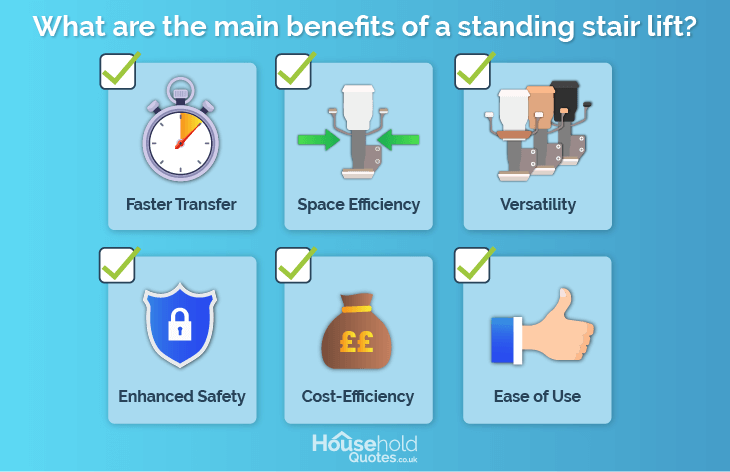
Stand-on stair lifts offer several benefits, making them a popular choice for individuals with mobility issues who may have difficulty navigating stairs. Here are some of the main advantages:
- Faster transfer: Stand-on stair lifts allow users to quickly and easily transfer onto the lift without needing to sit down. This can be particularly advantageous for individuals who have difficulty sitting or standing for extended periods, as it eliminates the need to transition between sitting and standing positions.
- Space efficiency: Stand-on stair lifts require less space compared to traditional seated stair lifts. Their compact design makes them ideal for installation on narrow or steep staircases where space may be limited. This feature is particularly beneficial for homes with tight stairwells or unconventional layouts.
- Versatility: Stand-on stair lifts are suitable for a wide range of users, including those who may have trouble bending their knees or hips sufficiently to sit comfortably. This versatility makes them a practical option for individuals with varying mobility needs, allowing more people to safely access different levels of their home.
- Ease of use: Stand-on stair lifts are designed to be user-friendly, with simple controls and intuitive operation. Users can easily maneuver onto the lift platform and secure themselves in place, minimizing the need for assistance from others. This independence promotes self-reliance and enables individuals to move freely throughout their home without relying on caregivers or family members for assistance.
- Enhanced safety: Stand-on stair lifts are equipped with safety features such as seat belts, handrails, and sensors to detect obstructions along the staircase. These features help prevent accidents and ensure a secure and stable ride for users. Additionally, many stand-on stair lifts have swivel seats or platforms, allowing users to safely exit the lift at the top or bottom of the stairs.
- Cost-effectiveness: In some cases, stand-on stair lifts may be more cost-effective than seated models, particularly for individuals who do not require a seat or additional features. This affordability makes stand-on stair lifts an attractive option for budget-conscious consumers who are seeking a practical solution for improving accessibility in their home.
Overall, stand-on stair lifts offer a convenient, space-saving, and user-friendly solution for individuals with mobility challenges, allowing them to safely and independently navigate stairs with ease.
What brands provide standing stair lifts?
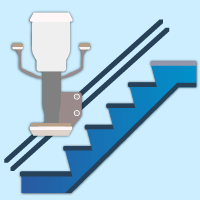
In the UK, there are several reputable brands that provide standing stair lifts. This offers a variety of options to suit different needs and preferences. Among several, here are some of the best stairlift companies in UK:
Stannah Stairlifts
Stannah is one of the most well-known and trusted names in the stairlift industry, with a wide range of products including standing stair lifts. Their standing models are known for their durability, safety features, and smooth operation. Stannah offers customizable options to fit various staircase configurations and user requirements.
Acorn Stairlifts
Acorn is another prominent brand in the UK stairlift market, offering standing stair lifts alongside their seated models. Acorn's standing lifts are designed for ease of use and comfort, with features such as swivel seats, safety sensors, and slimline designs to maximize space efficiency.
Handicare
Handicare provides a range of mobility solutions, including standing stair lifts designed to enhance accessibility in homes. Their standing models offer reliability, safety, and ergonomic design, allowing users to navigate stairs with confidence and independence. Handicare's lifts are known for their smooth ride and quiet operation.
Brooks Stairlifts
Brooks specializes in providing affordable yet high-quality stairlift solutions, including standing models. Their standing lifts are designed with user comfort and safety in mind, featuring ergonomic handrails, adjustable footrests, and intuitive controls. Brooks stairlifts are known for their reliability and straightforward installation process.
Platinum Stairlifts
Platinum offers a range of innovative stairlift solutions, including standing models that are tailored to meet the specific needs of users. Their standing lifts are known for their robust construction, advanced safety features, and customizable options. Platinum prioritizes user comfort and ease of use, ensuring a smooth and hassle-free experience.
Benefits of these brands include
All of these renowned brands mentioned above have many benefits and that includes:
- Reliability: These brands are recognized for their reliability and durability, providing peace of mind to users.
- Safety features: Each brand incorporates advanced safety features into their standing stair lifts, such as seat belts, sensors, and emergency stop buttons, ensuring a secure and stable ride.
- Customization: Many of these brands offer customizable options to accommodate different staircase configurations and user preferences, allowing for a tailored solution.
- Comfort: Standing stair lifts from these brands are designed with user comfort in mind, featuring ergonomic designs, padded seats, and adjustable footrests to ensure a comfortable experience during use.
- Customer support: These brands typically offer excellent customer support, including installation services, maintenance, and after-sales assistance, ensuring a positive experience for users throughout the lifespan of their stair lift.
Types of standing stairlifts
Standing stair lifts come in various configurations and designs to cater to different user requirements and staircase layouts. You should choose a stairlift which suits your needs the best. Below are the types of standing stairlifts available:
Compact Standing stairlifts
Compact standing stair lifts are engineered to fit into narrow or tight spaces, making them ideal for homes with limited staircase width or unconventional layouts. Despite their smaller footprint, they provide a secure standing platform for users, ensuring ease of use while navigating stairs.
Straight Standing stairlifts
Straight standing stair lifts are designed for staircases with a simple, straight trajectory without curves or landings. They offer a direct ascent or descent along a linear track, providing a smooth and efficient ride for users. These models are typically easier to install and more cost-effective compared to curved variants.
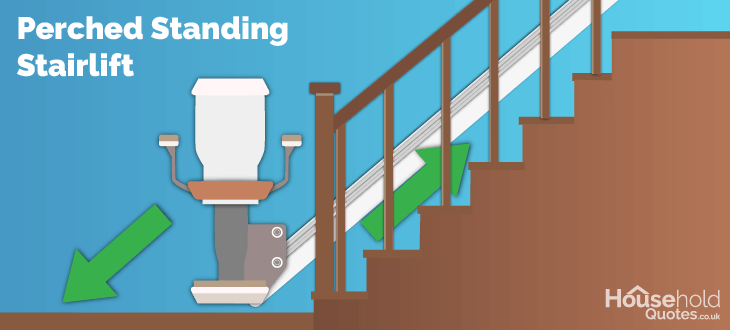
Perch Standing stairlifts
Perch standing stair lifts, also referred to as perching or leaning stair lifts, feature a small perch or leaning platform instead of a traditional seat. This design is suitable for individuals who find it challenging to sit or bend their knees for prolonged periods. Users can lean against a supportive rail while being transported along the stairs, enhancing comfort and stability.
Curved Standing stairlifts
Curved standing stairlifts are tailored to navigate staircases with curves, turns, or intermediate landings. Unlike straight models, curved variants are custom-built to match the specific shape and dimensions of the staircase. They employ a flexible track that can adapt to the curvature of the stairs, ensuring seamless travel between different levels of the home.
Outdoor Standing stairlifts
Outdoor standing stairlifts are designed to withstand outdoor elements such as rain, wind, and UV exposure. These models feature weather-resistant materials and components, ensuring durability and longevity in outdoor environments. They provide safe and reliable access to outdoor areas such as porches, decks, and garden terraces.
Folding Standing stairlifts
Folding standing stairlifts are equipped with platforms or seats that can be conveniently folded up when not in use. This space-saving feature allows for unimpeded access to the staircase for other household members. Folding models are particularly suitable for homes with limited space or narrow stairwells, providing a practical solution for accessibility without sacrificing convenience.
Small space Standing stairlifts
Small space standing stair lifts encompass designs that are optimized for compact staircases or areas with limited clearance. These lifts typically feature slimline tracks and minimalist profiles, allowing them to navigate tight spaces without compromising on safety or functionality.
Each type of standing stairlift caters to specific user needs and spatial requirements, ensuring that individuals with mobility limitations can safely and comfortably access different levels of their home.
Standing stair lift prices
Standing stair lift prices can vary depending on factors such as the type of lift, brand, features, installation requirements, and any customization needed. For a basic standing stair lift for a straight staircase, you can expect to pay between £2,000 and £5,000. For a more customized or curved standing stair lift, prices can range from £5,000 to £10,000 or more.
Here's an overview of the average costs for different types of standing stair lifts:
| Types of Standing Stairlift | Average cost (GBP) |
|---|---|
| Compact Standing Stairlift | £2,000 - £4,000 |
| Straight Standing Stairlift | £2,500 - £5,000 |
| Perch Standing Stairlift | £3,000 - £6,000 |
| Curved Standing Stairlift | £5,000 - £10,000+ |
| Outdoor Standing Stairlift | £3,500 - £7,000 |
| Folding Standing Stairlift | £2,500 - £5,500 |
| Small Space Standing Stairlift | £2,000 - £4,500 |
| Reconditioned Standing Stairlift | £1,500 - £3,000 |
Typically, straight stairlifts are less expensive than their curved counterparts. This is because they are made for stairs that do not have any bends or twists, simplifying and reducing the cost of installation. Nonetheless, the final price can fluctuate based on various aspects like the manufacturer, the inclusion of extra features, and any specific customisations.
The cost of a standing stair lift depends on several factors:
- Type of lift: As shown in the table above, different types of standing stair lifts have varying price ranges. Curved stairlifts tend to be more expensive due to their custom-built nature, while straight or compact models may be more affordable.
- Features and options: Additional features such as swivel seats, safety sensors, remote controls, and upholstery choices can increase the cost of the stair lift.
- Brand: Established brands with a reputation for quality and reliability may have higher prices compared to lesser-known manufacturers.
- Customization: If the staircase requires any customization, such as extra rail length or specific design adjustments, this can increase the overall cost of the installation.
- Installation: Installation costs can vary depending on the complexity of the staircase, any structural modifications required, and the location of the installation.
- Warranty and service: Some manufacturers may offer extended warranties or service plans for an additional cost, which can provide added peace of mind but may also increase the upfront price.
It's important for individuals considering a standing stair lift to obtain quotes from multiple providers, compare features and prices, and consider long-term maintenance and service costs in addition to the initial purchase price. Additionally, some funding or assistance programs may be available to help offset the cost of accessibility equipment for those who qualify.
Can you get a standing stair lift for free?

In the UK, it's possible to get a standing stairlift for free in certain circumstances, but this typically involves qualifying for government assistance programs or grants aimed at helping individuals with disabilities or mobility issues. Here are some potential avenues to explore:
- NHS Wheelchair Services: In some cases, individuals may be eligible for a standing stairlift through the National Health Service (NHS) Wheelchair Services. Eligibility is typically determined based on medical need and mobility requirements.
- Disabled Facilities Grants (DFGs): These grants are available in England, Wales, and Northern Ireland to help individuals make adaptations to their homes to improve accessibility and independence. Eligibility is based on factors such as income and need, and the grants can cover the cost of installing a stairlift.
- Local Authority Funding: Some local authorities offer financial assistance or grants to residents who need home adaptations, including stair lift installations. Eligibility criteria and available funding vary depending on the specific policies of each local authority.
- Charitable Organizations: There are charities and organizations in the UK that provide financial assistance or donate equipment such as stairlifts to individuals in need. These organizations often have specific criteria for eligibility, so it's worth researching and reaching out to relevant charities in your area.
- Disability Benefits: If you receive certain disability benefits, such as Personal Independence Payment (PIP) or Disability Living Allowance (DLA), you may be able to use these funds to cover the cost of a stairlift installation.
Funding availability may be limited, so it's advisable to apply as early as possible and explore all available options for financial assistance.
How is a standing stair lift installed?
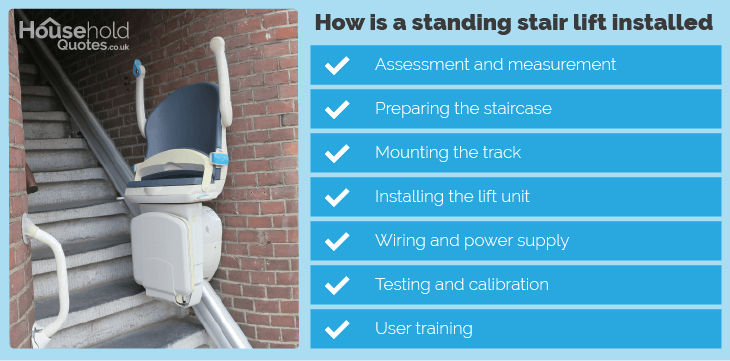
Installing a standing stair lift involves several steps to ensure proper functionality, safety, and compatibility with the user's staircase. Here's an overview of the typical installation process:
- Assessment and measurement: Before installation begins, a trained technician will conduct a thorough assessment of the staircase and surrounding area to determine the best placement and configuration for the stair lift. They will take precise measurements to ensure the lift fits correctly and can safely traverse the stairs.
- Preparing the staircase: Depending on the specific model and requirements, the staircase may need some preparation before installation. This could involve clearing any obstacles or clutter along the stairs and ensuring the area is clean and accessible for the installation process.
- Mounting the track: The track is the main component of the stair lift system and is typically attached directly to the stairs or adjacent wall using brackets or supports. The track is customized to fit the specific dimensions and layout of the staircase, ensuring a secure and stable foundation for the lift.
- Installing the lift unit: Once the track is in place, the lift unit is installed onto the track. This includes attaching the carriage or platform that the user will stand on during operation. The lift unit is securely fastened to the track and tested to ensure smooth movement along the stairs.
- Wiring and power supply: Electrical wiring is connected to the lift unit to provide power for operation. This may involve routing wires along the track or through the wall to reach the nearest power source. The technician ensures that all electrical connections are properly secured and compliant with safety regulations.
- Testing and calibration: Once the installation is complete, the technician conducts thorough testing of the stair lift to ensure proper functionality and safety. This includes testing the controls, safety features, and weight capacity of the lift. The technician may also calibrate the lift to adjust settings such as speed and acceleration to meet the user's needs.
- User training: Before handing over the stair lift to the user, the technician provides comprehensive training on how to operate the lift safely and effectively. This includes instruction on using the controls, getting on and off the lift, and following safety precautions during use.
While it's technically possible to purchase a standing stair lift without installation, it's highly recommended to have a professional technician install the lift to ensure proper installation, safety, and compliance with regulations.
Attempting to install a stair lift without proper knowledge and expertise can lead to safety hazards, damage to the lift or staircase, and voiding of warranties. Additionally, many manufacturers and suppliers offer installation services as part of the purchase package to ensure a smooth and hassle-free experience for the user.
- Describe your needs
- Get free quotes
- Choose the best offer
It only takes 30 seconds

FAQ
Yes, there are standing stair lifts available. These types of stair lifts are designed for individuals who have difficulty sitting or require more support while standing. They allow users to stand securely on a platform or perch rather than sitting in a chair during transportation along the stairs.
Yes, there are alternatives to stair lifts depending on individual needs and circumstances. Some alternatives include home modifications like installing a ramp or a home elevator, depending on the layout and design of the home. Additionally, for individuals with less severe mobility issues, installing handrails or using mobility aids like walkers or canes may provide assistance on stairs.
Getting a stair lift for free is rare, but there are certain avenues to explore. Some charities or organizations may provide financial assistance or grants to individuals with disabilities to help cover the cost of accessibility equipment like stair lifts. Additionally, in some cases, local government agencies or social services may offer funding or assistance programs for accessibility modifications in homes.
Generally, straight stairlifts tend to be more affordable compared to curved stairlifts. Straight stairlifts are designed for staircases without any curves or turns, making them easier and less expensive to install. However, prices can vary depending on factors such as brand, features, and additional customization.
On average, a standing stair lift can range from around £2,000 to £5,000 or more, including installation. The cost of a standing stair lift in the UK can vary depending on several factors, including the brand, model, staircase configuration, and any additional features or customization options.
Stair lifts are not typically available through the National Health Service (NHS) in the UK for home use. However, in certain cases where an individual’s mobility needs are deemed essential for their health and well-being, the NHS may provide funding or assistance for accessibility equipment like stair lifts. This usually involves an assessment by healthcare professionals to determine eligibility based on medical necessity.

Swathi’s journey in the field of content creation began with her education in journalism, where she developed a deep understanding of the power of words and the importance of effective communication.
